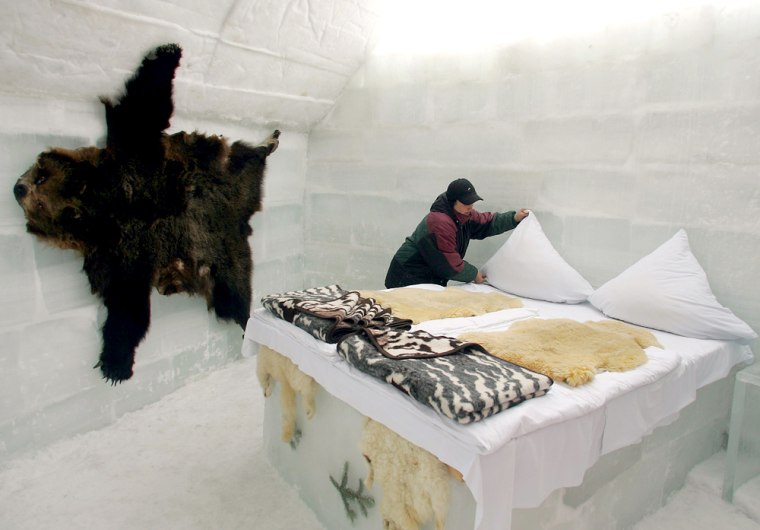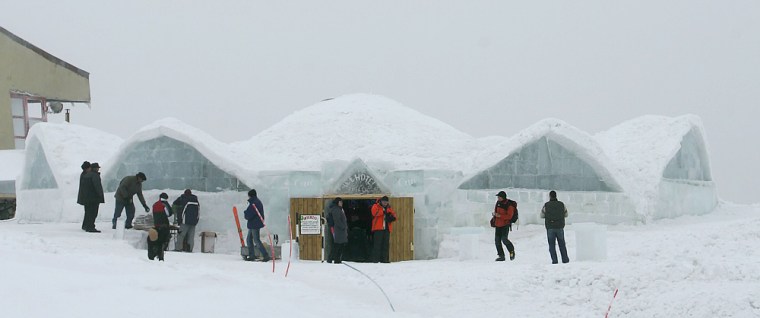Tucked away in a remote valley in Romania’s Carpathian mountains, a tiny ice hotel has opened to try and attract tourists and their cash to the unspoiled forests of some of Europe’s greatest wilderness.
A refuge for brown bears, wolves, bison, lynx and a wealth of other wildlife and plant species found nowhere else, the region needs money to tackle the poverty that environmentalists say could threaten the mountains.
Arnold Klingeis hopes his eight-room hotel, built 6,500 feet above sea level and accessible only by cable car in the winter, will attract tourists interested in nature. Nearby areas could be further developed for skiing, some say.
“This area has the resources to become a European tourist attraction. But we need investment,” said Klingeis, a 27-year-old Romanian-born German who runs the hotel, during its opening.
“In the winter there are no foreigners here and local developers don’t have the budget for a ski lift.”

Made of ice from a nearby lake, the igloo-shaped hotel cost less than $12,100 and took a month to build. Next to the sheepskin-covered ice beds, a local artist put icy copies of the sleek sculptures by Romanian-born modernist sculptor Constantin Brancusi.
Romania, one of Europe’s poorest countries which hopes to join the European Union next year, is struggling to build up its tourist industry saddled with crumbling, communist-era infrastructure.
Government officials estimate that up to 6 million tourists visit Romania each year, heading for Black Sea beaches dotted with mineral mud spas or following the footsteps of notorious medieval ruler, Vlad the Impaler, whose life inspired Bram Stoker’s “Dracula.”
The uninhabited slopes around Balea Lac, an icy lake surrounded by some of the highest peaks of the Carpathians, a vast mountain chain that spans much of eastern Europe, could be another attraction, local residents said.
“This pristine charm is what used to attract people to the Alps,” said Paul Philippi, a retired theology professor from the nearby town of Sibiu.
“The Alps don’t have it any more. These mountains...have sheep and not much more,” he said, leaning against an ice table in one of the new hotel’s bedrooms.
At the moment, Balea Lac attracts only the most devout skiers, who scramble up the slopes, with only one small, beginners’ lift available to give them a pull.
According to Romania’s National Ski Federation, there are 23 ski runs in the mountainous country and only five of them meet international standards.
Mountain care
A seven-nation plan to protect the Carpathian mountains, backed by the United Nations, came into force last month, seeking to protect wildlife, promote sustainable development and preserve the cultures of the up to 18 million inhabitants.
Environmentalists say that cash is needed to prevent poverty-driven over-exploitation of natural resources and pollution. A structured development of the area would be more environmentally friendly and that costs money.
In the valley of Balea Lac, mountain lovers say there is plenty of room for tourists and their cash.
“This area is beautiful. It’s got huge potential,” said Sorin Brinzan, a 26-year-old bartender from Bucharest who skis around the lake, on the slopes of Romania’s two highest peaks.
“We believe in this project,” he said, while a hotel worker behind him used an electric drill to turn cubes of ice into drinking glasses and filled with them palinca, a Romanian type of plum brandy popular in eastern and central Europe.
Many local residents say mountain villages are better off than some other regions in Romania, where average monthly salaries are less than $250 a month and many city dwellers cannot afford their winter heating bills.
As in any region in Romania, local authorities are struggling to find new employment sources after communist-era industries collapsed following the 1989 fall of the Ceausescu government.
In Sweden, cash spent by tourists beating a trail to the world’s first ice hotel built 125 miles north of the Arctic Circle, created jobs in a depressed region.
“This is not a very poor area but we need investment,” said Dorin Magda, the mayor of the nearby village of Cartisoara, standing below an icy vaulted ceiling that crowns the new hotel’s bar and sports a twinkling disco ball.
“Before 1989 there was industry. Now we need to find a new direction.”
